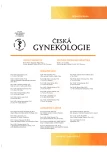Modern terminology and classification of female pelvic organ prolapse
Authors:
I. Horvath 1; M. Polišenská 2; Martin Huser 1,2
Authors‘ workplace:
Lékařská fakulta Masarykovy univerzity, děkan prof. MUDr. M. Bareš, Ph. D.
1; Gynekologicko-porodnická klinika LF MU a FN, Brno, přednosta doc. MUDr. V. Weinberger, Ph. D.
2
Published in:
Ceska Gynekol 2020; 85(2): 133-138
Category:
Overview
Objective: The aim of this study is to clarify the news and to summarize recommended methods in the quantification of female pelvic organ prolapse (POP).
Design: Summarizing study.
Setting: Department of Obstetrics and Gynecology, Masaryk University, University Hospital Brno.
Methods: The terminology of POP was significantly reworked in last decades. It is important to use common classification system for mutual communication of specialists and for exact interpretationof research.
Results: The older classifications of POP are not exact enough for interpretation of research. International classification system Pelvic organ prolapse quantification (POP-Q) brought necessary consensus in the terminology, encompassing many parameters that exactly define individual anatomy of each female patient. This detailed terminology could be replaced with simplified but also satisfactorily detailed version called Simplified POP-Q for the regular clinical practice. Modern classification of POP is still developing and new concepts of vaginal and perineal measurements for description of operation techniques effectiveness are waiting for further validation.
Conclusion: Modern terminology and classification of POP meets the requirements of current science and research and also is usable for regular clinical practice.
Keywords:
pelvic organ prolapse – classificati on – nomenclature – quantification
Sources
1. Baden, WF., Walker, TA. Genesis of the vaginal profile: a correlated classification of vaginal relaxation. Clin Obstet Gynecol, 1972, 15(4), p. 1048–1054.
2. Bump, RC., Mattiasson, A., Bø, K., et al. The standardization of terminology of female pelvic organ prolapse and pelvic floor dysfunction. Amer J Obstet Gynecol, 1996, 175(1), p. 10–17.
3. Halaška, M. Urogynekologie. 1. vyd. Praha: Galén, 2004, 256 s.
4. Hall, AF., Theofrastous, JP., Cundiff, GW., et al. Interobserver and intraobserver reliability of the proposed International Continence Society, Society of Gynecologic Surgeons, and American Urogynecologic Society pelvic organ prolapse classification system. Amer J Obstet Gynecol, 1996, 175(6), p. 1467–1471.
5. Haylen, BT., Maher, CF., Barber, MD., et al. An International Urogynecological Association (IUGA) / International Continence Society (ICS) joint report on the terminology for female pelvic organ prolapse (POP). Int Urogynecol J, 2016, 27(2), p. 165–194.
6. Haylen, BT., Ridder, D. De, Freeman, RM., et al. An International Urogynecological Association (IUGA) / International Continence Society (ICS) joint report on the terminology for female pelvic floor dysfunction. Int Urogynecol J, 2010, 21(1), p. 5–26.
7. Chmel, R., Vlk, R., Horčička, L. Účinnost a bezpečnost TVT operace v „době učení“ metody. Čes Gynek, 2003, 68(2), s. 94–98.
8. Krčmář, M., Záhumenský, J., Šottner, O., et al. Přehled operačních technik užívaných ke korekci poruch statiky pánevního dna. Čes Gynek, 2006, 71(6), s. 464–468.
9. Martan, A., Mašata, J., Švabík, K. Nové operační a léčebné postupy v urogynekologii: řešení stresové inkontinence moči, defektů pánevního dna a OAB u žen. 2., rozšířené a přepracované vyd. Praha: Maxdorf, 2013, 230 s.
10. Michalec, I., Tomanová, M., Navrátilová, M., et al. Rizikové faktory poškození svalů pánevního dna v souvislosti s vaginálním porodem. Čes Gynek, 2015, 80(1), s. 11–15.
11. Parekh, M., Swift, S., Lemos, N., et al. Multicenter inter-examiner agreement trial for the validation of simplified POPQ system. Int Urogynecol J, 2011, 22(6), p. 645–650.
12. Swift, S., Morris, S., McKinnie, V., et al. Validation of a simplified technique for using the POPQ pelvic organ prolapse classification system. Int Urogynecol J, 2006, 17(6), p. 615–620.
Labels
Paediatric gynaecology Gynaecology and obstetrics Reproduction medicineArticle was published in
Czech Gynaecology

2020 Issue 2
Most read in this issue
- Is the finding of endometrial hyperplasia or corporal polyp an mandatory indication for biopsy?
- Modern terminology and classification of female pelvic organ prolapse
- Laparoscopic correction of isthmocele combined with ventrosuspensios of uterus
- MODY diabetes and screening of gestational diabetes
